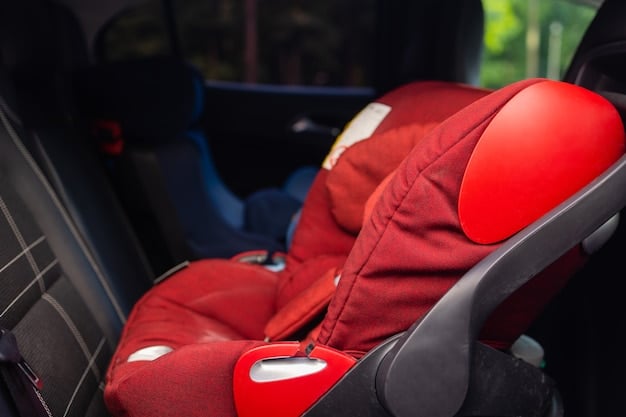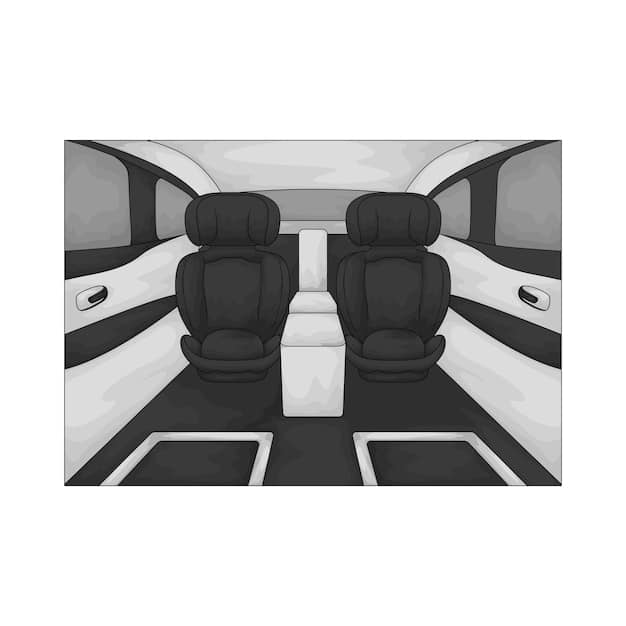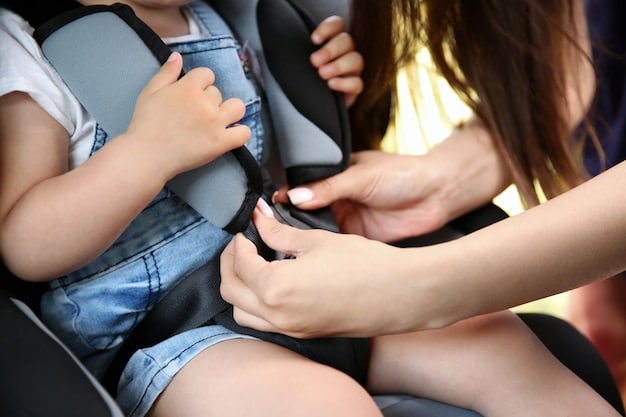Is Your Baby’s Car Seat Installed Correctly? Fix Common Mistakes

Ensuring your baby’s car seat is correctly installed is crucial for their safety; common mistakes include incorrect angle, loose harness, and improper positioning, all of which can be fixed by carefully following the manufacturer’s instructions and seeking professional help when needed.
Ensuring your child’s safety while traveling is paramount, and a properly installed car seat is non-negotiable. But, is your baby’s car seat installed correctly? Common mistakes can compromise your child’s safety, even if you believe you’ve done everything right. Let’s explore these pitfalls and how to avoid them.
Understanding Car Seat Safety Standards
Car seat safety standards are designed to protect children in the event of a car accident. These standards are set by organizations like the National Highway Traffic Safety Administration (NHTSA) and are constantly evolving to incorporate new research and technologies. Understanding these standards is the first step in ensuring your child’s car seat is installed correctly.
Federal Motor Vehicle Safety Standards (FMVSS)
The FMVSS are a set of regulations that dictate the performance requirements for car seats. These standards cover everything from the materials used to the seat’s ability to withstand impact forces during a crash. Car seats sold in the US must meet these standards to be considered safe.
NHTSA Guidelines and Recommendations
The NHTSA provides guidelines and recommendations for car seat use, including choosing the right seat for your child’s age and size, proper installation techniques, and best practices for securing your child in the seat. They also offer resources like recall lists and safety ratings to help parents make informed decisions.
Understanding these guidelines and standards can seem overwhelming. Key aspects to remember are the weight and height limits of each car seat, the importance of registering your car seat to receive recall notices, and the critical stages of car seat usage.
- Weight and Height Limits: Always adhere to the manufacturer’s recommended weight and height limits for your car seat.
- Registration: Register your car seat with the manufacturer to receive recall notices in case of safety issues.
- Car Seat Stages: Understand the different stages of car seat usage: rear-facing, forward-facing, and booster seat.

By familiarizing yourself with car seat safety standards and guidelines, you’ll be better equipped to ensure your child’s safety while on the road. It also empowers you to double-check your installation and usage to ensure it meets the requirements, providing you with peace of mind.
Common Car Seat Installation Mistakes
Even with the best intentions, it’s easy to make mistakes during car seat installation. These errors can significantly reduce the effectiveness of the car seat in protecting your child. Recognizing these common mistakes is crucial for ensuring your child’s safety.
Incorrect Angle of the Car Seat
One of the most common mistakes is not achieving the correct angle for rear-facing car seats. The angle is crucial to prevent the baby’s head from flopping forward and obstructing their airway. Many car seats have built-in levels or angle indicators to help you achieve the correct position.
Loose LATCH Connectors or Seatbelt
The LATCH (Lower Anchors and Tethers for Children) system or the vehicle’s seatbelt are used to secure the car seat. A loose connection can allow the car seat to move excessively during a crash. Ensure the connectors are tightly secured and the seatbelt is locked properly.
These installation mistakes, although common, can be detrimental to your child’s safety. In addition to the angle and stability, other common errors include incorrect harness placement and prematurely transitioning to a forward-facing seat.
- Harness Placement: The harness straps should be at or below the shoulders for rear-facing seats and at or above the shoulders for forward-facing seats.
- Premature Transition: Keep your child in each car seat stage (rear-facing, forward-facing, booster seat) for as long as possible, adhering to the maximum weight and height limits.
- Using Expired Seats: Car seats have expiration dates. Using an expired seat can be dangerous as the plastic may become brittle over time.
Being aware of these common errors and taking the necessary steps to correct them is essential. It might be useful to consult the car seat’s manual or seek hands-on help from a certified child passenger safety technician.
Step-by-Step Guide to Correct Car Seat Installation
Correctly installing a car seat can seem daunting, but breaking it down into a step-by-step process can make it more manageable. This guide will walk you through the essential steps for installing a car seat correctly, whether using the LATCH system or the vehicle’s seatbelt.
Preparing for the Installation
Start by gathering all necessary materials, including the car seat manual, vehicle owner’s manual, and a towel or pool noodle if needed to achieve the correct angle. Read both manuals thoroughly to understand the specific instructions for your car seat and vehicle.
Installing with the LATCH System
If your vehicle and car seat are equipped with the LATCH system, locate the lower anchors in your vehicle’s seat. Attach the car seat’s lower anchor connectors to these anchors, ensuring they click into place. Tighten the connectors until the car seat is secure and doesn’t move more than one inch side to side or front to back.
The LATCH system provides a simplified method for installing car seats, but it’s crucial to ensure it is installed properly. Key steps include checking compatibility, using the tether when forward-facing, and knowing when to switch to the seatbelt method.
- Check Compatibility: Ensure both your vehicle and car seat are compatible with the LATCH system.
- Use the Tether: When using a forward-facing car seat, always use the top tether to further secure the seat.
- Know When to Switch: Be aware of the weight limits for the LATCH system in your vehicle and switch to the seatbelt method when necessary.

Following these steps carefully ensures that the car seat is properly and tightly installed. Always double-check your work and, if you have any doubts, seek help from a certified child passenger safety technician. They can provide hands-on assistance and ensure that the car seat is installed correctly.
Addressing Specific Car Seat Types
Different types of car seats require different installation techniques and considerations. Whether you have an infant seat, a convertible seat, or a booster seat, understanding the specific requirements for each type is essential for ensuring your child’s safety.
Infant Car Seats
Infant car seats are designed for newborns and small babies and are always installed rear-facing. They typically come with a base that stays in the car, making it easy to remove the carrier. The base must be installed at the correct angle to prevent the baby’s head from flopping forward.
Convertible Car Seats
Convertible car seats can be used rear-facing and forward-facing, making them a versatile option for growing children. Ensure you follow the weight and height limits for each position and adjust the harness accordingly.
Each type of car seat brings its unique requirements, and being aware of these nuances is crucial to ensure accurate installation. Key considerations include proper usage, weight limits, and other practical advice.
- Proper Usage: Always use the car seat specifically for its intended purpose.
- Weight Limits: Stay within the weight and height limits for each type of seat and position.
- Additional Advice: Regularly check the car seat for wear and tear and replace it if necessary.
By addressing the specific requirements of each car seat type, you can provide your child with optimal protection and ensure they are safe. It’s always a wise idea to periodically review the manufacturer’s instructions to guarantee the correct usage.
The Importance of the Harness and Straps
The harness and straps are critical components of a car seat, responsible for keeping your child secure during a crash. Correctly adjusting and using the harness can significantly reduce the risk of injury. Understanding the importance of these elements is paramount.
Proper Harness Positioning
The harness straps should be positioned at or below the shoulders for rear-facing seats and at or above the shoulders for forward-facing seats. The straps should be snug but not too tight, allowing only one finger to fit between the strap and your child’s collarbone.
Chest Clip Placement
The chest clip should be positioned at armpit level, not on the child’s stomach or neck. This clip helps keep the harness straps in the correct position and prevents them from slipping off the child’s shoulders during a crash.
Incorrect harness and strap usage is a common determinant of car seat safety failure. Essential aspects to consider include strap tightness, correct positioning, and the proper management of bulky clothing.
- Strap Tightness: Ensure the harness straps are snug, allowing only one finger to fit between the strap and your child’s collarbone.
- Correct Positioning: Adjust the straps to the correct height based on whether the seat is rear-facing or forward-facing.
- Bulky Clothing: Avoid dressing your child in bulky clothing or coats, as these can compress in a crash and create slack in the harness.
Paying close attention to the harness and straps ensures a safe and comfortable ride for your child. Consistently verifying the adjustment and appropriateness of these features can potentially mitigate the risk of injury.
Seeking Professional Help and Resources
Even with careful attention to detail, car seat installation can be challenging. Fortunately, there are numerous resources available to help parents ensure their child’s car seat is installed correctly. Seeking professional help can provide peace of mind and ensure your child’s safety.
Certified Child Passenger Safety Technicians
Certified Child Passenger Safety Technicians (CPSTs) are trained to assist parents with car seat installation. They can inspect your car seat, provide hands-on assistance, and answer any questions you may have. CPSTs can be found at local fire stations, hospitals, and health departments.
Local Car Seat Inspection Stations
Many communities offer car seat inspection stations where certified technicians are available to check your car seat installation. These stations provide a valuable service and can help identify and correct any mistakes.
Leveraging available tools and resources is always advocated when aiming for the best possible safety outcomes. Important resources include CPST assistance, online tutorials, and community events.
- CPST Assistance: Utilize certified Child Passenger Safety Technicians for hands-on help and guidance.
- Online Tutorials: Refer to online videos and instructional materials for visual guidance.
- Community Events: Participate in local car seat safety events for expert advice and inspections.
Consulting these resources adds an additional layer of safety, ensuring that any potential oversights are identified and rectified. Ultimately, the combined effect of personal effort and expert support guarantees the highest degree of child safety.
| Key Point | Brief Description |
|---|---|
| 📐 Correct Angle | Ensure rear-facing seats are at the correct angle to protect baby’s airway. |
| 🔒 Secure LATCH | Tighten LATCH connectors or seatbelts until the seat barely moves. |
| 🧵 Harness Position | Straps should be at/below shoulders (rear-facing) or at/above (forward-facing). |
| 📅 Check Expiry | Car seats have expiry dates; do not use expired seats, as plastic can become breakable. |
Frequently Asked Questions
▼
Check for movement; it shouldn’t move more than one inch side to side or front to back. Also, make sure the harness straps are snug, and the chest clip is at armpit level. Consider having a CPST inspect it.
▼
LATCH (Lower Anchors and Tethers for Children) is a system designed to make car seat installation easier. Lower anchors connect the seat to the vehicle’s frame, and a tether strap provides added stability for forward-facing seats.
▼
Keep your child rear-facing as long as possible, until they reach the car seat’s maximum height or weight limit. This is usually around 2-4 years old. Rear-facing is safer for longer.
▼
Registering your car seat allows the manufacturer to contact you in case of a recall due to safety concerns. This ensures you’re promptly informed of any issues and can take necessary corrective actions.
▼
Seek help from a certified Child Passenger Safety Technician (CPST). They can inspect your car seat, provide hands-on assistance, and answer any questions you may have, ensuring a correct and safe installation.
Conclusion
Ensuring your baby’s car seat is correctly installed is a critical aspect of child safety. By understanding car seat standards, recognizing common installation mistakes, and seeking professional help when needed, parents can significantly reduce the risk of injury and provide their children with optimal protection while traveling.





